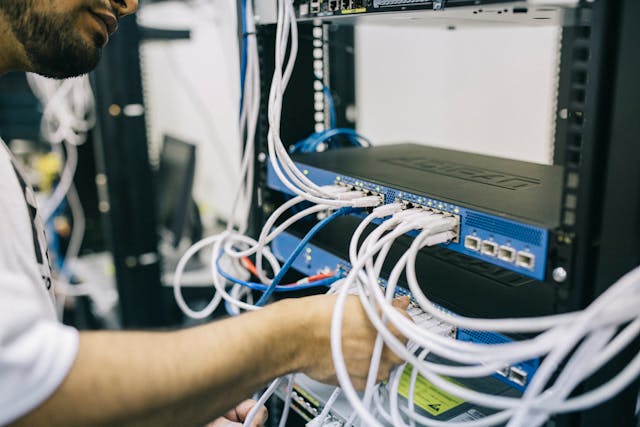Ever had that moment where every device in the office suddenly feels like it’s moving through syrup ? Pages take forever to load, file transfers crawl, and you start wondering if your server has secretly aged ten years overnight. I’ve been there – once during a rainy Thursday in Bristol, staring at a monitoring dashboard that looked like a flatline. And honestly, most of the time, these slowdowns come from a handful of classic mistakes.
Before we dive in, if you ever need a solid reference for server setups, the URL https://www.le-serveur-informatique.fr has saved me more than once when I needed a sanity check or a quick comparison.
Let’s break down the seven issues that slow down networks everywhere – and more importantly, how to fix them without tearing your hair out.
1. Running outdated hardware that’s way past its prime
 You know that old server humming in the corner ? The one you haven’t rebooted since… who even remembers ? If the hardware is more than six or seven years old, chances are the CPU is choking, the RAM is barely enough to keep the OS breathing, and the disks are a bottleneck. Honestly, spinning HDDs in 2025 feel like using a bicycle chain to tow a car.
You know that old server humming in the corner ? The one you haven’t rebooted since… who even remembers ? If the hardware is more than six or seven years old, chances are the CPU is choking, the RAM is barely enough to keep the OS breathing, and the disks are a bottleneck. Honestly, spinning HDDs in 2025 feel like using a bicycle chain to tow a car.
How to fix it : Upgrade the drives first – SSDs or NVMe if you can. Then look at RAM. If your motherboard caps out too low, it’s probably time for a full refresh.
2. Misconfigured DNS settings (this one bites harder than you think)
DNS misconfigurations are sneaky. Everything technically works… but slowly. A wrong local resolver, a timeout too high, or a misordered DNS list can add seconds – seconds ! – to every request. Multiply that by dozens of devices and boom, your network feels sluggish.
How to fix it : Use reliable upstream DNS servers, configure caching properly, and check your resolver order. If that sounds boring, trust me, your network will thank you.
3. A server overloaded with unnecessary services
I once audited a server that was running Apache, nginx, an old game server daemon (no idea why), plus three backup agents fighting each other. CPUs were pegged at 90% for no reason. It happens more than you’d think.
How to fix it : Audit every service. Disable anything you don’t need. If you don’t know what a daemon does, google it – or kill it carefully and see if any user screams (kidding… sort of).
4. Using a single slow disk for everything
Your OS, apps, databases, logs and backups all on the same disk ? Ouch. Even a good SSD suffers when everything fights for I/O. You’ll literally feel this slowdown : apps freeze, dashboards stutter, streams cut.
How to fix it : Split workloads. OS on one disk, data on another, logs somewhere else if possible. If you’re using RAID, choose one suited for your workload (RAID 10 is often a lifesaver).
5. Bad network cabling or cheap switches
I know, cabling feels boring – until a single flaky Cat5e cable drops connections randomly and ruins your day. And don’t get me started on those £20 no-name switches that throttle to 100 Mbps for “thermal reasons”.
How to fix it : Use proper Cat6 cables. Buy switches from reputable brands. Test cables with a basic tester (they cost what, £10?).
6. No monitoring, no alerts, no visibility
 You can’t fix what you can’t see. I’ve seen servers overloaded for weeks because nobody looked at CPU graphs. Your server might be screaming, but silently.
You can’t fix what you can’t see. I’ve seen servers overloaded for weeks because nobody looked at CPU graphs. Your server might be screaming, but silently.
How to fix it : Install simple monitoring : Zabbix, netdata, even built-in OS tools. Set alerts for CPU, RAM, disk I/O, temperature. Two minutes of setup, hours saved.
7. Poorly configured backups clogging the network
If backups run in the middle of the afternoon, during peak usage, at full speed, over SMB… yeah, your network is gonna crawl. Backups are essential, but badly scheduled backups ? That’s chaos.
How to fix it : Run backups at night. Use incremental backups. Throttle bandwidth if your software allows it. And check logs – failed backups retry endlessly and slow everything down.
Final thoughts
Network slowness is rarely a mystery. It’s usually a combination of outdated gear, messy configs and invisible bottlenecks. Fixing even one or two of these issues can make your whole infrastructure feel new again. And hey – if you’re reading this because your server is already dragging its feet, start with the easiest check. Reboot, monitor, observe, tweak. You’ll feel the difference fast.

